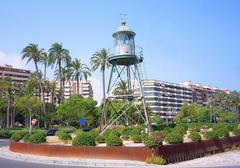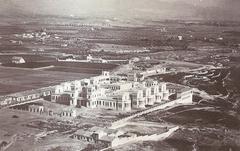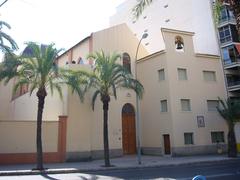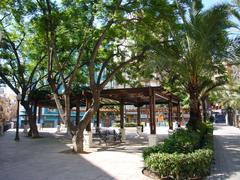Complete Guide to Visiting Torre d’Aigües in Alicante
Date: 01/08/2024
Introduction
The Torre d’Aigües, also known as the Water Tower, is a prominent historical landmark situated in the town of Aigües, near Alicante, Spain. This iconic structure, dating back to the 19th century, was originally constructed to serve as a water reservoir, playing a crucial role in the local agricultural economy by ensuring a steady water supply. The tower stands as a testament to the engineering advancements and architectural ingenuity of its time, constructed from robust local materials and traditional techniques that highlight the region’s architectural heritage.
Visiting the Torre d’Aigües offers a unique opportunity to delve into the rich history of Alicante, a region influenced by various civilizations, including the Iberians, Phoenicians, Romans, Goths, Moors, and Spaniards. This comprehensive guide aims to provide detailed insights into the historical significance, visitor information, and travel tips to enhance your experience at this remarkable site. Whether you are a history enthusiast, an architecture aficionado, or simply looking to explore a piece of Spain’s cultural heritage, the Torre d’Aigües is a must-visit destination. (Castlepedia, View from La Vila)
Table of Contents
- Introduction
- Historical Background of Torre d’Aigües
- The 19th Century in Alicante
- Preservation and Restoration
- Visitor Experience
- Travel Tips
- Educational Value
- FAQ
- Conclusion
Historical Background of Torre d’Aigües
Origins and Early History
The Torre d’Aigües was constructed in the 19th century during a period of significant advancements in engineering and infrastructure in Spain. It served as a water reservoir, ensuring a steady supply of water to the local population and agricultural lands.
Architectural Significance
The tower is a cylindrical structure built with robust materials, reflecting the architectural ingenuity of the time. The use of local stone and traditional construction techniques highlights the region’s architectural heritage.
Role in Local Agriculture
The Torre d’Aigües was crucial in supporting the agricultural economy of the region by providing a reliable source of water, essential for maintaining crop yields and supporting the local population.
Historical Context
The construction of the Torre d’Aigües must be understood within the broader historical context of Alicante, a region with a rich history influenced by various civilizations, including the Iberians, Phoenicians, Romans, Goths, Moors, and Spaniards.
The 19th Century in Alicante
Technological Advancements
Innovations in engineering and construction techniques in the 19th century allowed for the creation of more efficient and durable water storage structures like the Torre d’Aigües.
Cultural and Social Impact
The Torre d’Aigües symbolizes the ingenuity and resilience of the local population in addressing water scarcity challenges. It has become a part of the region’s cultural heritage.
Preservation and Restoration
Efforts to preserve and restore the Torre d’Aigües aim to maintain its structural integrity and historical significance. These initiatives often involve collaboration between local authorities, historians, and conservation experts.
Visitor Experience
Visiting Hours and Tickets
The Torre d’Aigües is open to visitors year-round. Visiting hours are from 9 AM to 6 PM daily. Tickets can be purchased on-site or online, with prices ranging from €5 for adults to €3 for children and seniors.
Guided Tours
Guided tours are available and provide detailed information about the tower’s history, construction, and role in the local community. Tours are conducted in multiple languages.
Special Events
The tower hosts various events throughout the year, including historical reenactments and cultural festivals. Check the official website for the latest information on upcoming events.
Photographic Spots
The Torre d’Aigües offers several scenic spots perfect for photography, capturing both the architectural beauty of the tower and the surrounding landscape.
Travel Tips
Accessibility
The site is accessible to visitors with disabilities, with ramps and elevators in place.
Nearby Attractions
Visit nearby historical sites such as the Castle of Santa Bárbara and the Archaeological Museum of Alicante (MARQ).
Transportation
The tower is accessible by car, with ample parking available. Public transportation options include buses and taxis.
Educational Value
The Torre d’Aigües serves as an educational resource, offering insights into historical water management and agricultural development. Schools often organize visits, and the tower’s history is incorporated into local curricula.
FAQ
What are the Torre d’Aigües visiting hours?
The tower is open daily from 9 AM to 6 PM.
How much are the tickets?
Tickets cost €5 for adults and €3 for children and seniors.
Are guided tours available?
Yes, guided tours are available and provide comprehensive information about the tower.
Conclusion
The Torre d’Aigües stands as a testament to historical efforts in water management and agricultural development in the Alicante region. Its construction reflects the technological advancements and economic prosperity of the 19th century. Today, it remains an important cultural and historical landmark, offering valuable insights into the region’s past and serving as a symbol of the local community’s resilience and ingenuity. Plan your visit to appreciate its architectural beauty and historical significance. (Castlepedia, View from La Vila)
References
- Castlepedia, 2019, Castlepedia
- View from La Vila, 2019, View from La Vila
- A World to Travel, 2019, A World to Travel














